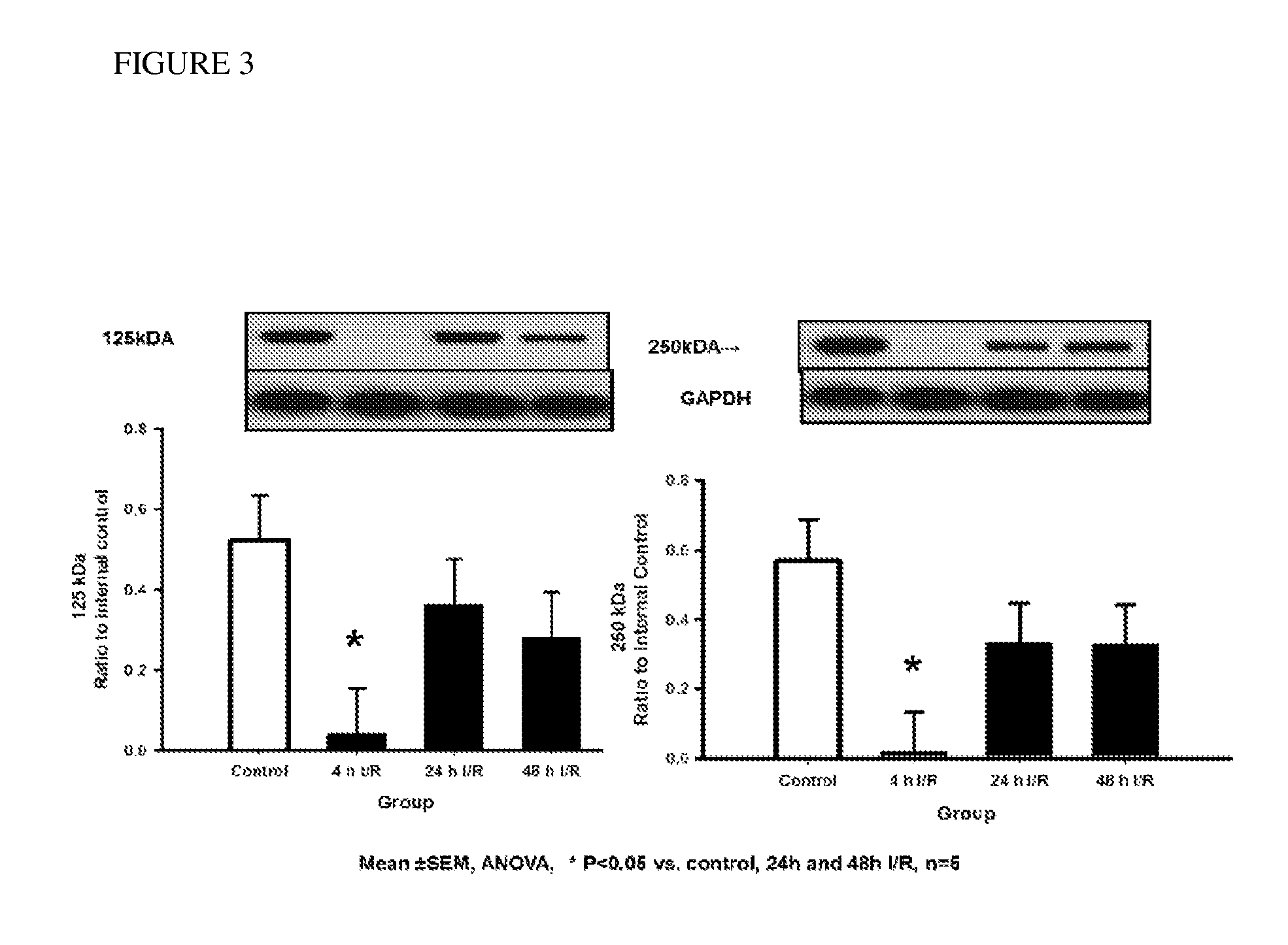Treatment of disease using inter-alpha inhibitor proteins
a technology of interalpha inhibitors and proteins, which is applied in the direction of peptide/protein ingredients, cardiovascular disorders, drug compositions, etc., can solve the problems of increasing affecting tissue function, and information is also very limited regarding the distribution of iaip molecules among different organs, so as to treat, reduce, or inhibit a condition, and reduce the incidence of brain damage in premature infants. , to achieve the effect of treating, reducing
- Summary
- Abstract
- Description
- Claims
- Application Information
AI Technical Summary
Benefits of technology
Problems solved by technology
Method used
Image
Examples
example 1
IAIPs Attenuate Ischemic Brain Injury in the Ovine Fetus
[0102]We exposed fetal sheep to ischemia / reperfusion injury.4, 5, 88 Sections stained with Luxol fast blue-hematoxylin / eosin (LFB-H&E) to delineate white matter lesions showed homogeneous blue stained myelin and healthy appearing cerebral cortex in control (FIG. 4A, 1×) in contrast to ischemic (FIG. 4B, 1×) brains that exhibited decreased blue staining and cerebral cortical thinning indicating severe white matter and neuronal loss, respectively. Fetal sheep treated with IAIPs (4 mg / kg 15 min, 24 & 48 h after carotid occlusion, FIG. 4C, 1×) showed remarkable preservation of white matter and cerebral cortex. A pathologist, unaware of treatments, scored the sections according to the percentage of neuronal and white matter destruction using a grading system that we previously reported (FIG. 6).4, 5, 88 The pathological scores indicated severe cerebral cortical and white matter injury in fetuses exposed to ischemia / reperfusion (clos...
example 2
Ontogeny of Inter Alpha Inhibitor Proteins in Ovine Brain and Somatic Tissues IAIPs Detection by ELISA and Western Immunoblot in Plasma
[0103]IAIPs detected by the sheep specific ELISA in ovine plasma were lower (P<0.05) in the fetuses at 70% and 90% gestation than in the newborn lambs, and lower in the fetuses at 90% of gestation than in adult sheep.
[0104]The IAIPs were detected as 125 kDa and 250 kDa bands in ovine plasma by Western immunoblot. The expression of 125 kDa band did not differ among the age groups. In contrast, the expression of 250 kDa band was lower in the fetuses at 70% and 90% gestation, and in the newborn lambs than in the adult sheep.
[0105]IAIPs Detection by Western Immunoblot in Cerebral Cortex, CP and CSF.
[0106]IAIPs were detected in cerebral cortex, CP and CSF as 125 kDa and 250 kDa protein bands by Western immunoblot using the specific antibody against IAIPs. The expression of 125 kDa band was higher in the cerebral cortex in fetuses at 70% and 90% of gestati...
example 3
IAIPs Provide Neuroprotection Prior to Stroke and Following Hypoxia / Ischemia in Neonates
[0135]Neurological impairment secondary to oxygen deprivation, including hypoxia / ischemia (HI) associated with immaturity of vasculature and pulmonary insufficiency in premature and very low birth-weight infants, as well as HI events relating to birth, is the leading cause of neurologic morbidity and mortality in infants. Affected children are prone to long-term cognitive and behavioral deficits. Moreover, severity of injury and pathological outcome are dependent upon sex, with more substantial long-term deficits identified in male than female infants, even when matched for severity of injury. The cause(s) of these differences are largely unknown; however, data indicate sex differences in apoptotic mechanisms, suggesting sex-specific mechanism of HI-induced injury. We propose novel studies to examine this sex-based phenomenon, specifically with regard to underlying molecular / cellular features of ...
PUM
| Property | Measurement | Unit |
|---|---|---|
| body weight | aaaaa | aaaaa |
| body weight | aaaaa | aaaaa |
| temperature | aaaaa | aaaaa |
Abstract
Description
Claims
Application Information
 Login to View More
Login to View More - R&D
- Intellectual Property
- Life Sciences
- Materials
- Tech Scout
- Unparalleled Data Quality
- Higher Quality Content
- 60% Fewer Hallucinations
Browse by: Latest US Patents, China's latest patents, Technical Efficacy Thesaurus, Application Domain, Technology Topic, Popular Technical Reports.
© 2025 PatSnap. All rights reserved.Legal|Privacy policy|Modern Slavery Act Transparency Statement|Sitemap|About US| Contact US: help@patsnap.com



